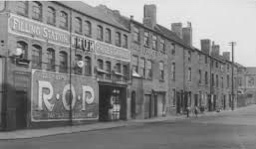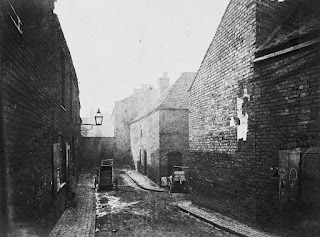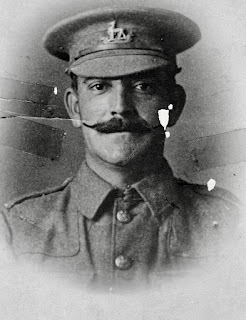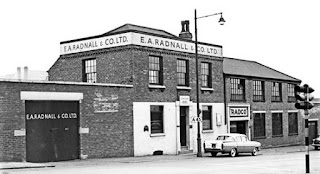Grandfather: William Ernest Ray, 1883-1941…
I was never fortunate enough to meet my dad’s father, for he passed away in 1941, when my dad was only 21 years of age. I know that when he was unwell, my grandfather asked my dad to visit his grave when he had died and drink a beer there. My father did just that…
 |
| A LITTLE MORE PORTLY HERE... |
My dad told me that William had ‘run away to the circus’ when he was 14 years of age and had experienced tightrope walking, as well as being the person who climbed to the top of a human pyramid, then toppled from the summit to forward-roll out of his fall. Naturally, William was not very tall…
 |
| RATHER SMALL IN STATURE... |
Considering that my father loved being in the army during World War II, he didn’t mention William’s experiences in World War I, although I do have the medals awarded to my grandfather. However, my dad reckoned that one of William’s ancestors ‘brought the wooden bicycle wheel to Birmingham’, which seemed a very odd, if confident statement to make.
 |
| A RESIGNED SMILE... |
Having lost his first wife in 1905, probably during the birth of a second child, William soon married my Nan, Lilian ‘Wilson’, although having just received Nan's birth certificate, no father is included.
The research is ongoing. That first wife was Lilian Maud Mary Hammond, whose father was a cycle maker, which was crucial, for William was a cycle handlebar polisher, apparently… It appears that he lived at 137 Heneage Street with her, although they weren’t married until 12th April 1903 and daughter Lilian Winifred came along in the August of that year.
 |
| Heneage Street... |
When William married my Nan, they were both living in Duddeston Mill Road, presumably with Nan looking after William’s daughter. They were married on 4th March 1906.
 |
| GRANDAD WITH NAN, MY DAD, SHEILA & CONNIE... |
William worked at Radnall’s in Dartmouth Street, apparently on Raleigh cycles, until 1940, the year before he died, aged just 58. He had apparently been struggling with his breathing, resulting from World War I gas attacks, the fumes from the metal polish he had used at work, also from smoking cigarettes and likely too from the coal dust which no doubt lingered around the ‘coal-house’ off the kitchen in the later marital home of 347 Bromford Lane, near the famous racecourse.
In 1901, aged 17 (he was born in December 1883) the family was living in Holt Street, number 29, I believe, along with older brother Joseph, an edge tool maker and his younger siblings Ann, Frederick, George and Samuel. William was listed as an iron polisher.
His father was a barrel welder, whilst his mother Ann hailed from Manchester, a member of the Best family but in 1891, when the family lived at 4 Court 20, Staniforth Street, she was listed as a spoon polisher and husband Joseph was described as a gun barrel welder, which adds more clarity to the aforementioned ‘barrel welder’…
 |
| STANIFORTH STREET... |
It appears that in 1881, the 22 year olds Joseph and Ann lived at 2 Staniforth Street and their son Joseph was 3 months old, but an older sister Angelina, 2 years old, was there too, although apparently she died when she was about 4.
In 1871, 13 year old Joseph was living at 26 Balloon Street with siblings William, Thomas and Richard. Their father, 35 year old Samuel R(e)ay was a wheelwright (the wooden wheel man?) and his wife was Neomiah, aged 30…
Strangely, at 24 Balloon Street, a Joseph Ray, who was even more oddly, a gun barrel welder, lived as a lodger…
 |
| TAKEN FROM A CORNER OF BALLOON STREET... |
However, back to William…
He joined up to fight in the Great War in 1914 and I believe he travelled to the Front before Christmas that year, arriving on 3rd December, his 31st birthday and might have even have been nearby when the famous Christmas Truce and football match were held…
It was confusing that William went to France so soon but it turns out that he had joined the 6th Battalion of the Royal Warwickshire Regiment Militia on 4th June, 1901, with a service number of 8267. He was working in Vesey Street at a cycle works, under a Mr Croft, who agreed for William to join the Militia as a part-time soldier. He was described as being 5 feet 4 inches (1.62 metres) tall, 114 pounds in weight (just over 8 stones, or 51.7kg), with black hair, brown eyes and a fresh complexion. He signed on for 6 years and the Militia disbanded soon afterwards anyway.
Strangely, his attestation date of 4th June would be the same date 19 years later, when his son (my dad Victor) was born…
So, at the outbreak of WW1, William joined the Royal Warwickshire Regiment and his new army number was 1856. He was sent to France and Flanders with the 1st Battalion, ending up on a list of casualties, ‘wounded’ on 15th July 1915. He wore a Wound Stripe on his uniform thenceforth.…
 |
| PRIVATE RAY... |
His grandson Leslie, from his son Leslie’s first marriage remembered sitting on William’s lap before he was evacuated to Repton in Derbyshire. He recalled Great War war medals being displayed on a wall at 347 Bromford Lane but that William was too often bringing up phlegm. Leslie was never to see his grandfather again.
 |
| BROMFORD RACECOURSE... |
 |
| ...& ITS SERVING RAILWAY STATION... |
William’s 80 year old mother Ann died around Christmas time in 1939, having been living in Vicarage Road, Aston. She had been born in Manchester it appears and by the age of 2, her father George Best (yes, I know…) was farming 40 acres of land at West Haddlesey, Yorkshire. In 1871, George was not only farming but the innkeeper at the George and Dragon pub in the village.
 |
| GEORGE & DRAGON, HADDLESEY... |
The image below shows the pub in modern times, when arson was suspected in 2019, after an attempted break-in.
George’s father had also been a farmer, working 47 acres in Chapel Haddlesey…
 |
| FARMLAND IN HADDLESEY... |
I know nothing about William’s sporting interests, although his son Will was an avid Birmingham City fan, often at odds with my dad, who supported Aston Villa. Later in life, dad used to drive a struggling Will to Villa Park to watch the Reserve team play on occasional Saturday afternoons, meeting Gary Shaw a few times in the process, one of Villa’s local goalscoring forwards.
I penned the following poem about Grandad Ray a few weeks back:
You Just Get Used To It…
Factory conditions.
Noise permanence.
Got used to it though.
Rumbling machinery.
Polishing bicycle handlebars to a gleam.
Industrial perdition.
Fumes intolerance.
Put up with it though,
The din and the flummery.
The future diminishing.
Any ambition a dream.
Trench conditions.
Noise preponderance.
Got used to it though.
Shambling acrimony.
Suffering mustard gas in the front line.
Ingestion, inhalation.
Blind insouciance.
Put up with it though.
The hell with camaraderie,
The future vanishing.
Any hope benign.
Horror conditions.
Noise indifference.
Got used to it though, you see.
Choking cacophony.
Staring at torn limbs in mud’s revealing.
Putrefaction, infection.
Bland acceptance.
Put up with it though, you see.
The fear of ill chance.
The future banished.
No likely healing.
Chest condition.
Noise interference.
Got used to it though, you know.
Smoking, pitifully.
Wearing diseased lungs to gasping.
Deception, dissatisfaction.
Fumes dependence.
Put up with it though, you know.
The pain through reliance.
The future tarnished.
At life grasping…
Pete Ray
13th January 2021
This poem was meant to be about getting used to seeing death, horror and maiming during the First World War.
However, as I began to write it, my paternal grandfather came to mind, whose peacetime job had been polishing bicycle handlebars.
He fought in WW1 trenches and suffered during poison gas attacks.
After the Great War he wheezed, apparently due to a combination of the polish fumes, German gas and of course, cigarettes.
He died in the mid-1930s and therefore I never met him…
So, this poem is dedicated to William Ernest Ray, my grandfather, of the Royal Warwickshire Regiment…









Hi Cousin
ReplyDeleteFascinating to read about your grandad.
William Ernest was my grandad Samuel's older brother.
Cheers.
Jonathan